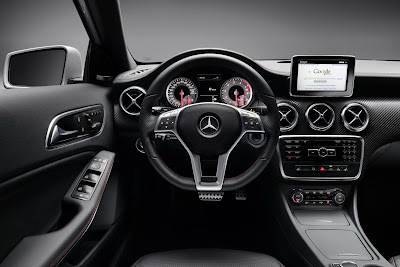2013 Mercedes-Benz A-Class Review, The new basic engine in the OM 607 series develops 80 kW (109 hp), delivers 260 Nm to the crankshaft and with a manual transmission consumes 3.8 litres per 100 km, corresponding to 98 g of CO2/km. This is a 22-percent improvement over the only 60 kW (82 hp) preceding model, the A 160 CDI, which consumed 4.9 litres. The new top diesel, the A 220 CDI, is no less than 25 percent better than its predecessor: it develops an output of 125 kW (170 hp) and 350 Nm of torque, and in combination with the 7G-DCT automatic dual clutch transmission it consumes only 4.3 litres/100 km (provisional figure). The figures for the preceding A 200 CDI were 103 kW(140 hp), 5.7 litres, and 149 g of CO2/km.
2013 Mercedes-Benz A-Class Review
A comparison between the new and previous A 200 demonstrates what has been achieved with the petrol engines: with 115 kW(156 hp) and 250 Nm of torque, the new engine delivers superior performance but consumes only 5.4 litres/100 km (127g CO2/km – figures for the 7G-DCT), which is 26 percent less than its predecessor (100 kW, 185 Nm, 7.4 l/100 km, 174 g CO2/km). Even the new top model with the 7G-DCT and producing 155 kW(211 hp) and 350 Nm is considerably more efficient with a consumption of 6.1 litres and CO2 emissions of 143 g.
The completely new engines and transmissions are not the only decisive factors in this exemplary efficiency. Thanks to the modular system it has been possible to select the optimally designed transmission for each diesel and petrol engine. The overall package is rounded off perfectly with progressive aerodynamics with a Cd figure of only 0.27, as well as a number of other improvements.
With all engine variants, the Mercedes-Benz A-Class comes with disc brakes on all wheels. The callipers on the rear axle and the brake boosters are made of aluminium. A particularly convenient feature is the HOLD function, which is familiar from the larger model series: when stopping, for example at traffic lights, the driver merely has to press the brake pedal slightly more firmly and the brake will remain engaged until he moves off again. The brake is released automatically when the driver steps on the accelerator. On versions with manual transmission, the Hill Hold function automatically prevents the vehicle from rolling back unintentionally when starting on a slope.
The Mercedes-Benz A-Class is equipped with an electric parking brake, which operates by means of actuator motors acting on the callipers of the rear axle. The parking brake is activated via a button under the light switch on the left of the dashboard. This creates additional space in the centre console, as the handbrake lever is no longer required. When the button is pressed at speeds of over four km/h, the parking brake acts as an emergency brake, activating all four wheel brakes via the ESP®’s hydraulic unit.
In conjunction with the 7G-DCT automatic transmission, the parking brake offers a particularly convenient mode of functioning: when the driver accelerates sufficiently after fastening their seat belt, the parking brake is released automatically.


















1 comment:
Post a Comment